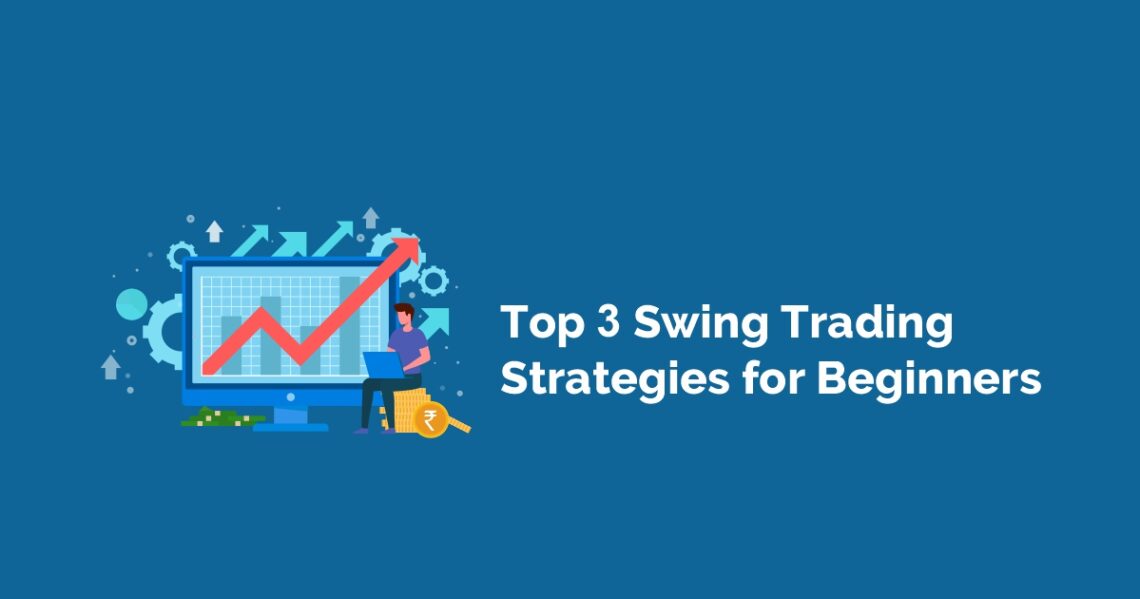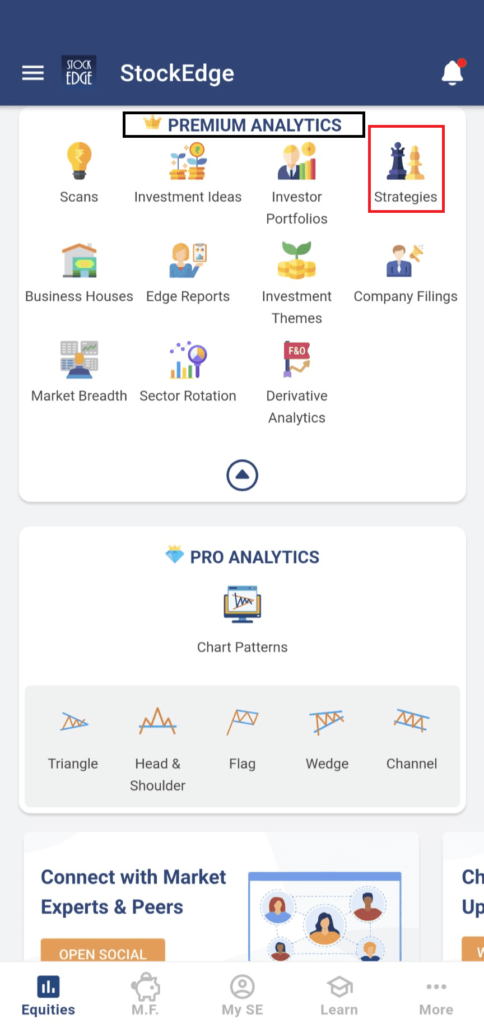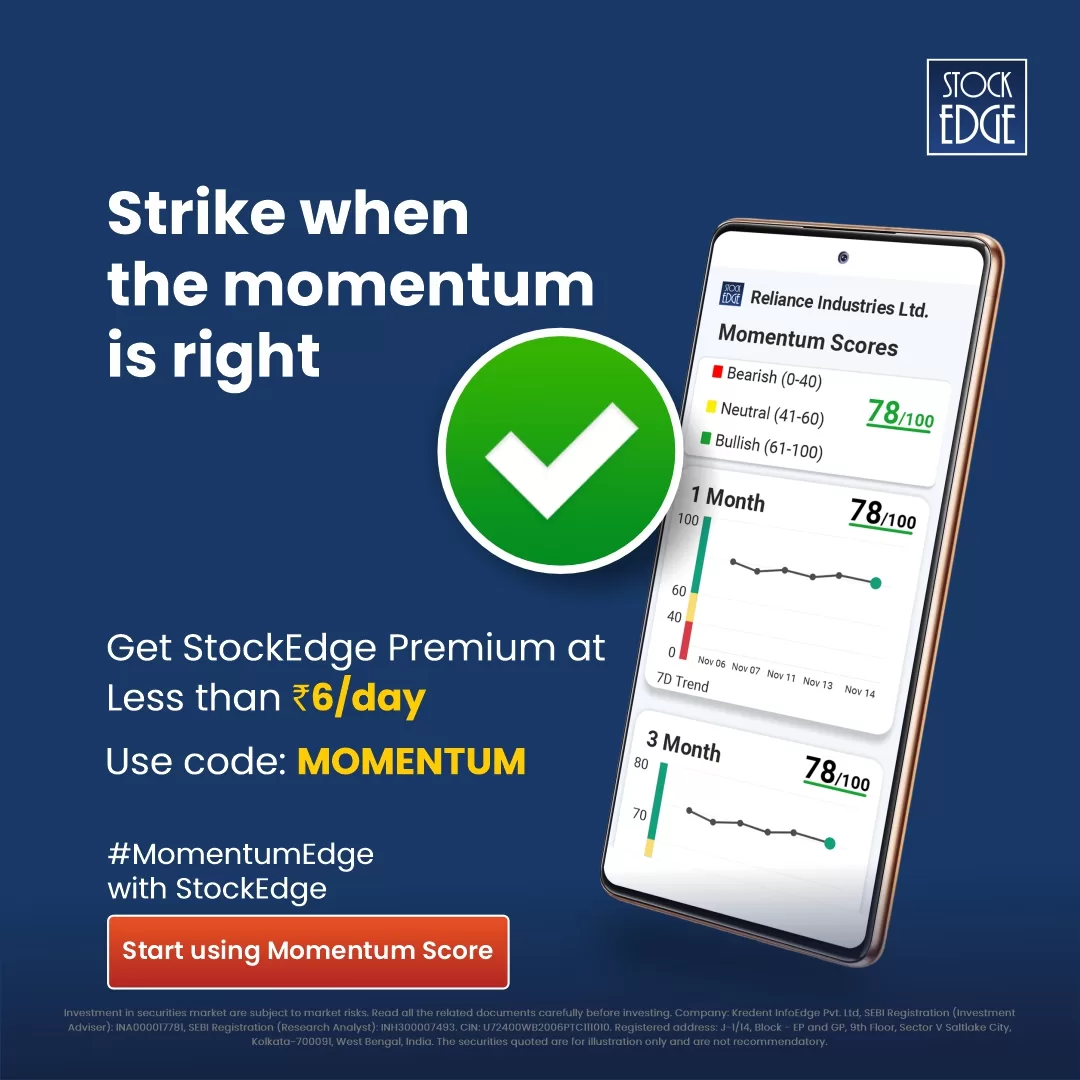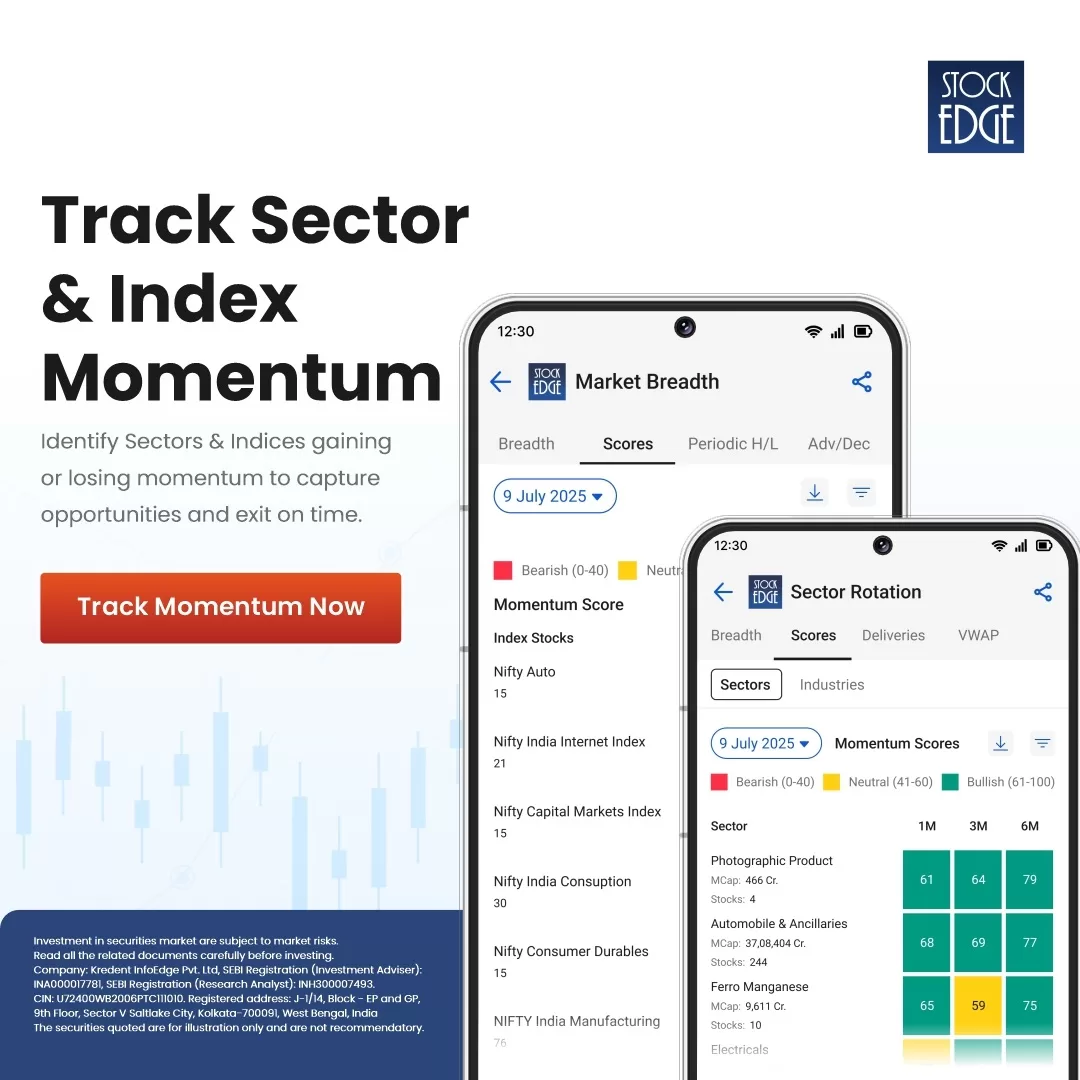Key Takeaways
- What Swing Trading Means: Swing trading focuses on capturing price moves that unfold over a few days to weeks, making it ideal for traders who can’t track markets all day.
- Breakout Strategy: This approach identifies stocks breaking above resistance or chart patterns with strong volume, allowing traders to ride fresh momentum after consolidation.
- SMA-Based Trading: Simple Moving Averages help smooth price movements; trades are taken when price crosses key SMAs or when two SMAs cross each other, signalling trend direction.
- MACD Strategy: MACD crossovers reveal momentum shifts. Bullish or bearish crossovers — especially around the zero line — offer reliable entry and exit opportunities.
- Importance of Risk Control: Successful swing trading needs stop-losses, proper position sizes, and awareness of high-volatility events to avoid unexpected losses during overnight holds.
- Key Takeaways
- Understanding Swing Trading
- The Basics of Swing Trading Strategies
- What Makes a Good Swing Trading Strategy?
- The First Strategy: Breakout Swing Trading
- Tool for identifying Swing Trading Opportunities: StockEdge
- The Second Strategy: SMA (Simple Moving Average)
- The Third Strategy: MACD (Moving Average Convergence Divergence)
- How to Apply MACD in Trading?
- How to Manage Volatility in Swing Trading?
- Why Choose Swing Trading Over Other Trading Methods?
- What are the Key Steps to Start Swing Trading?
- Should You Consider Swing Trading as a Full-Time Job?
- Pros and Cons of Being a Full-Time Swing Trader
- The Bottom Line
- Frequently Asked Questions (FAQs)
Swing trading is a fantastic way for beginners to get started in the stock market. It’s all about taking advantage of short to medium-term price movements, which allows you to adapt to changing market conditions. As the famous swing trader Mark Minervini puts it, “Swing trading offers the flexibility you need to succeed.” In this blog, we’ll explore the top three swing trading strategies that are perfect for newcomers and explain why swing trading is such a popular choice among traders.
Before we understand the three most powerful swing trading strategies and why swing trading is such a popular strategy, first, let’s get the basics clear about swing trading.
Understanding Swing Trading
Swing trading is a simple way to trade stocks by taking advantage of price “swings”. It’s like riding a wave in the ocean – you catch the wave as it goes up and get off before it crashes down.
A stock does not go up or down in a straight line. Generally, a stock in an upward trend makes higher highs and higher lows, whereas a stock in a downward trend makes lower highs and lower lows.
Here’s a basic example: Imagine you’re looking at a stock and notice that it has been going up (making higher highs and higher lows) for a while, maybe a few days or weeks. You think, “Hmm, this stock seems on an uptrend. Right?”
So, as a swing trader, your target is to buy the stock at its swing low and sell it at its next swing high to pocket the difference between what you bought it for and what you sold it for. That’s your profit from swing trading.
The Basics of Swing Trading Strategies
Swing trading strategies are a well-defined and systematic approach to identify, execute, and manage trades with the goal of profiting from short to medium-term price swings of a stock. It is a set of rules and guidelines for making trading decisions. These swing trading strategies are typically based on technical analysis, which involves studying historical price charts, indicators, and patterns to forecast future price movements.
Before we jump into the complexities of swing trading strategies, let’s discuss some of the Do’s and Don’ts of Swing trading:
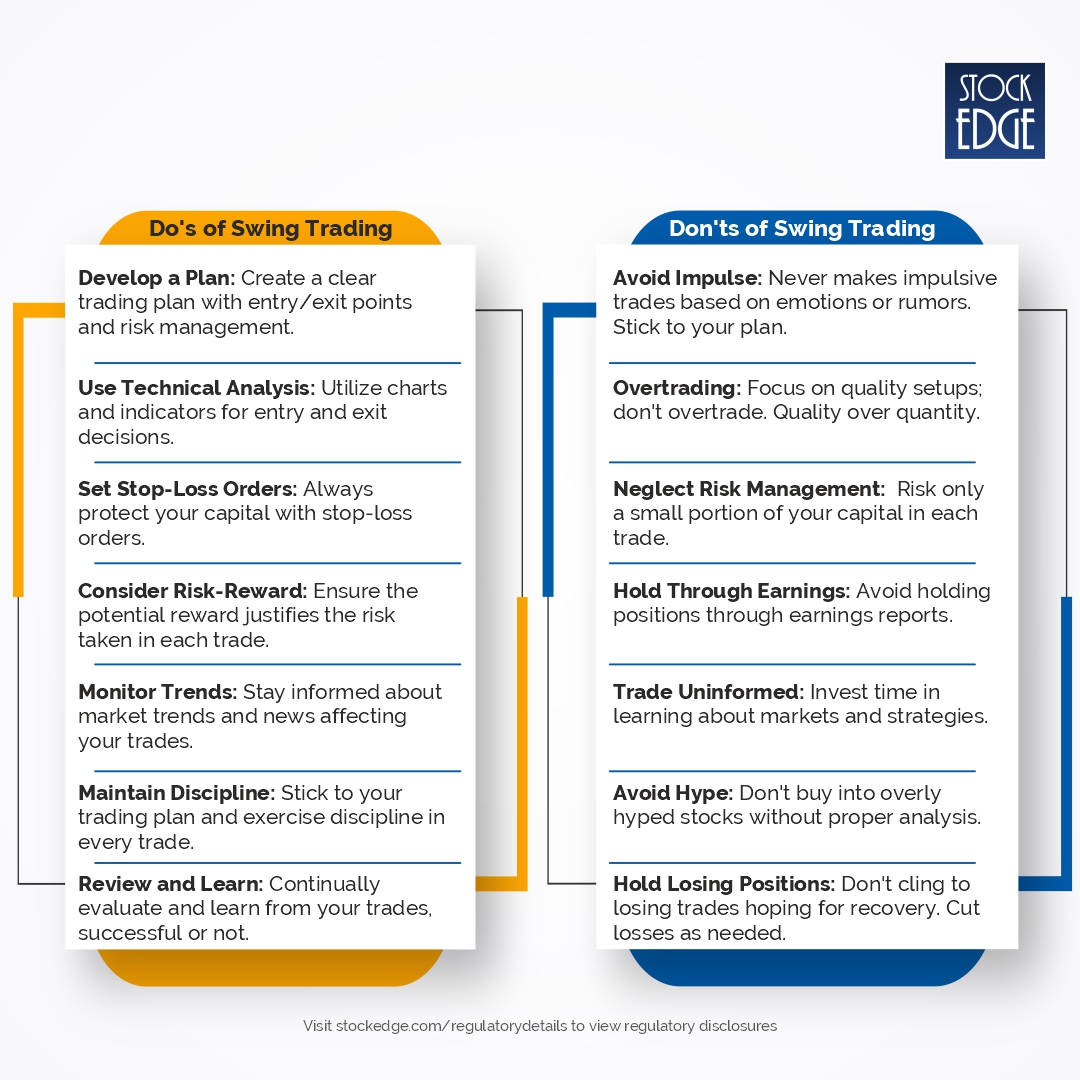
These guidelines provide a solid foundation for swing traders to navigate the markets effectively, manage risk, and improve their skills on various swing trading strategies.
Although the above do’s and don’ts of swing trading may act as a guideline for you, what makes a good Swing trading strategy requires a combination of knowledge, discipline, and adaptability of the stock market.
What Makes a Good Swing Trading Strategy?
Let’s explore what makes a good swing trading strategy through the wisdom of some famous swing traders:
- Technical Analysis Expertise: As Alexander Elder, a respected swing trader, advises, “To succeed in the market, you need the courage of a warrior but the calm of a Buddha.” A good strategy should incorporate a deep understanding of technical analysis, including chart patterns, indicators, and trend analysis, to identify favorable entry and exit points.
- Clear Rules and Risk Management: According to William O’Neil, founder of Investor’s Business Daily, “The whole secret to winning in the stock market is to lose the least amount possible when you’re not right.” A strong swing trading strategy should have well-defined rules for entry and exit, as well as a robust risk management system that limits potential losses.
- Flexibility: “In trading and investing, the ability to change one’s mind is a valuable asset,” notes George Soros. A good swing trading strategy should be adaptable to changing market conditions. Traders should be willing to adjust their approach when needed and not become overly attached to a single strategy.
- Emotion Control: Paul Tudor Jones emphasizes the importance of emotional control: “The most important rule of trading is to play great defense, not great offense.” A successful swing trading strategy should help traders control their emotions, avoid impulsive decisions, and stick to their plans.
- Risk-Reward Ratio: As Linda Raschke advises, “Risk more than you can afford to lose, and you will learn the game.” A good strategy should ensure that the potential reward justifies the risk in each trade, maintaining a favorable risk-reward ratio.
- Continuous Learning: “The goal of a successful trader is to make the best trades. Money is secondary,” emphasizes Alexander Elder. A strong strategy should encourage continuous learning and self-improvement, enabling traders to adapt to evolving market dynamics.
- Backtesting and Evaluation: Jesse Livermore, a legendary trader, once said, “The game taught me the game. And it didn’t spare me while teaching.” A good strategy involves rigorous backtesting on historical data and regular evaluation to learn from both successful and unsuccessful trades.
In essence, a good swing trading strategy combines technical analysis expertise, clear rules, effective risk management, adaptability, emotional discipline, and a commitment to ongoing learning. By incorporating these elements, traders can increase their chances of success and navigate the ever-changing dynamics of the stock market.
Let’s now dive into some of the best swing trading strategies one by one.
The First Strategy: Breakout Swing Trading
This is a very common swing trading strategy followed by traders across the world. But to identify stocks using this strategy, you must understand technical analysis well. This strategy aims to profit from short to medium-term price movements in stocks by identifying and capitalizing on breakouts, which are significant price movements that often follow periods of consolidation or range-bound trading.
Majorly, you have to use technical analysis tools like support and resistance levels, trendlines, and chart patterns like triangles or rectangles to identify potential breakout candidates. The idea is to find stocks that are poised for a significant price move. Also, volume is a vital confirmation factor. A breakout with increasing trading volume is often seen as more reliable than one with low or declining volume.
Let’s take a look at the daily chart of DLF Ltd., and when the price breaks out above the swing high, a significant upward trend has been witnessed.
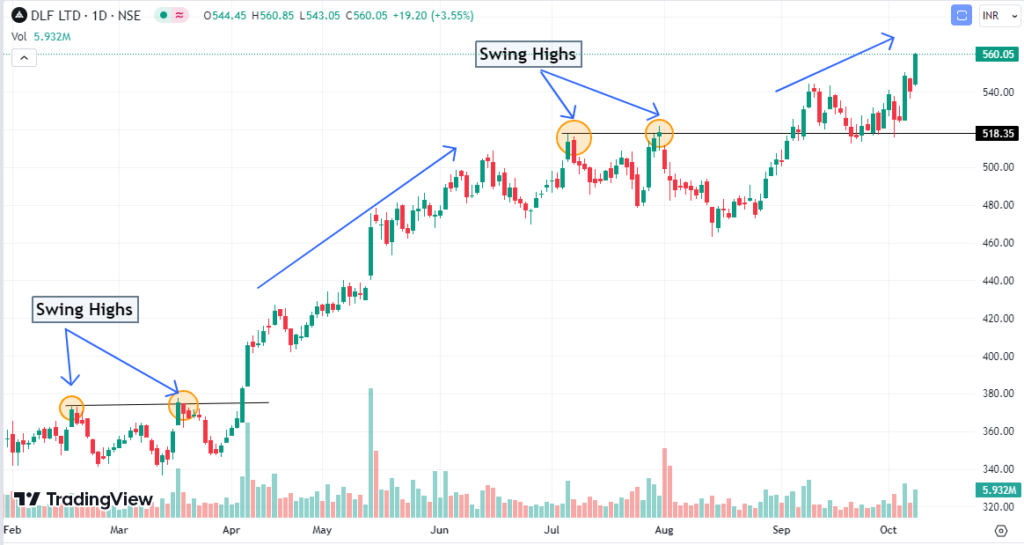
Well, that’s a very simple strategy you can apply on different time frames, be it 15 minutes, hourly or daily, as shown in the above example.
Tool for identifying Swing Trading Opportunities: StockEdge
For more advanced swing trading strategies, you may use our ready-made swing trading that you will find under the premium analytics section of StockEdge.
Under strategies, you will find not only swing trading strategies but also intraday and positional trading as well (both bullish and bearish)
Under each type of trading strategy, you will get multiple strategies that will help you identify stocks for trading.
Let’s see how you can filter out stocks for swing trading with the help of Dove (Continuation) trading strategy, which filters out strong stocks which are having upward potential over the next few days. The strategy identifies stocks that have already been in an uptrend for the past six months and have recently given a breakout above the previous day’s swing high along with two other technical indicators: RSI > 50 (trending up) and William %R Bullish.
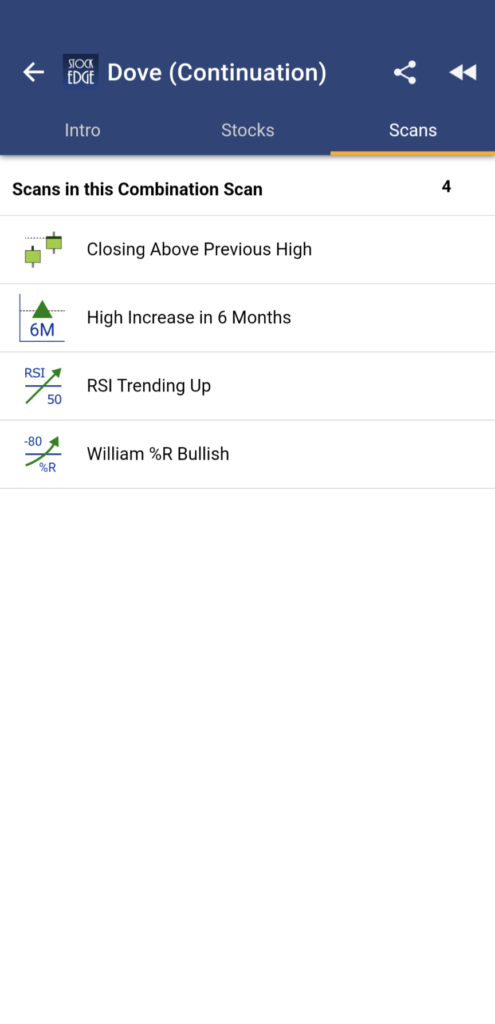
On 5th Oct this strategy filtered out a list of major stocks which matched the above criteria mentioned.
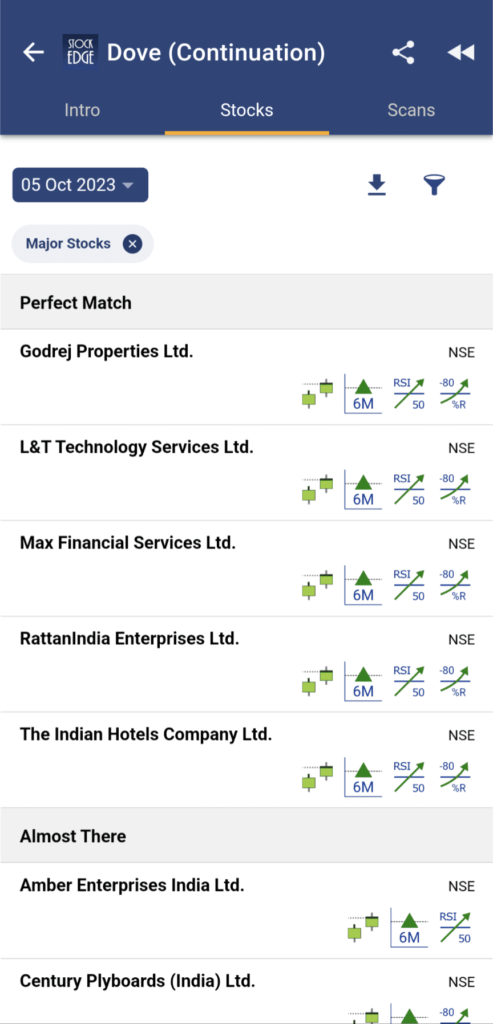
Let’s take a look at Godrej Properties Ltd. and how the stock has performed since then!
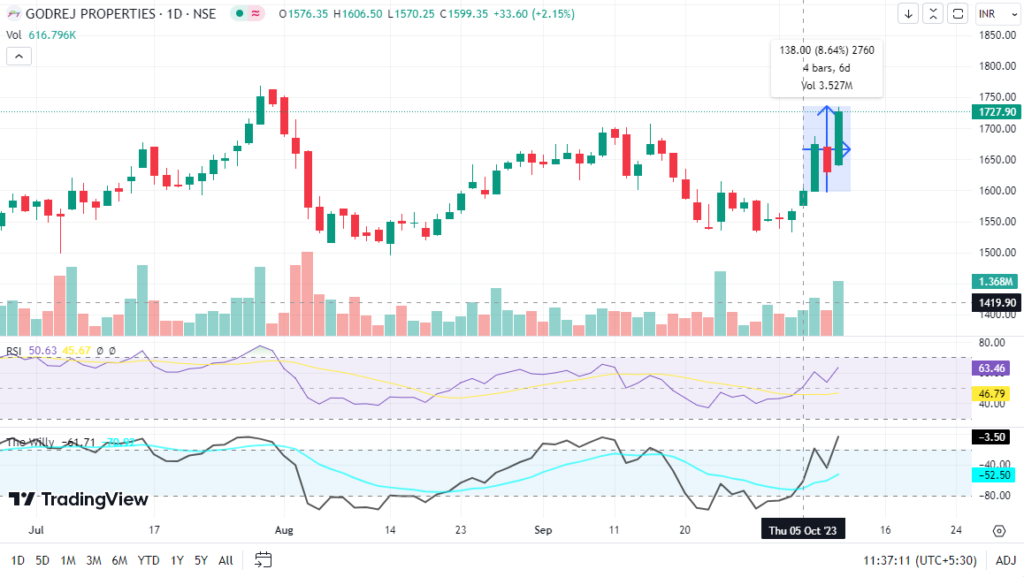
As you can see in the above price chart, the stock has moved more than 8% in 4 days, which is quite a sharp rise in stock price in a short time period. However, you may not always find such a sharp up move, and you must analyze the price chart before taking trades.
The Second Strategy: SMA (Simple Moving Average)
A Simple Moving Average, commonly known as (SMA) is the most widely used technical indicator for swing trading. The SMA is a basic form of moving average, and it’s calculated by taking the average of a stock’s closing prices over a specified period of time (commonly used time frames are 20,50,100 and 200 SMA). It is used to identify the trend of a stock as it smooths out price fluctuations. SMAs can be used for swing trading in multiple ways. Some of the common ways are mentioned below:
- Trend Identification: SMA helps traders identify the direction of the prevailing trend. If the current stock price is above the SMA, it’s often considered a bullish signal, suggesting an uptrend. Conversely, if the price is below the SMA, it’s seen as a bearish signal, indicating a downtrend.
- Support and Resistance Levels: The SMA can act as dynamic support and resistance levels. When the stock price approaches the SMA from below and bounces off it, it can be considered a potential buying opportunity (support). Conversely, when the price approaches the SMA from above and fails to break through, it may indicate a potential selling point (resistance).
- Crossovers: Traders often use crossovers in moving averages to generate buy or sell signals. One common crossover is the “Golden Cross” and “Death Cross.”
- Golden Cross: Occurs when a short-term SMA (e.g., 50-day) crosses above a longer-term SMA (e.g., 200-day), signaling a potential bullish trend reversal.
- Death Cross: Occurs when a short-term SMA crosses below a longer-term SMA, signaling a potential bearish trend reversal.
So, with the help of Golden Cross or Death Cross, you can identify stocks for trading. However, there are more than 6,000 stocks listed on the stock exchanges and finding SMA crossovers by analyzing the price chart of each stock seems impractical, right?
Therefore, we at StockEdge have developed Technical Indicator Scans so that you can easily identify stocks for trading. Simply go to Scans, which you will find under the Premium Analytics section of StockEdge and select Technical Scans. Under the first option, you will see Simple Moving Average Scans. Here, you will have an elaborative list of scans based on multiple moving averages.
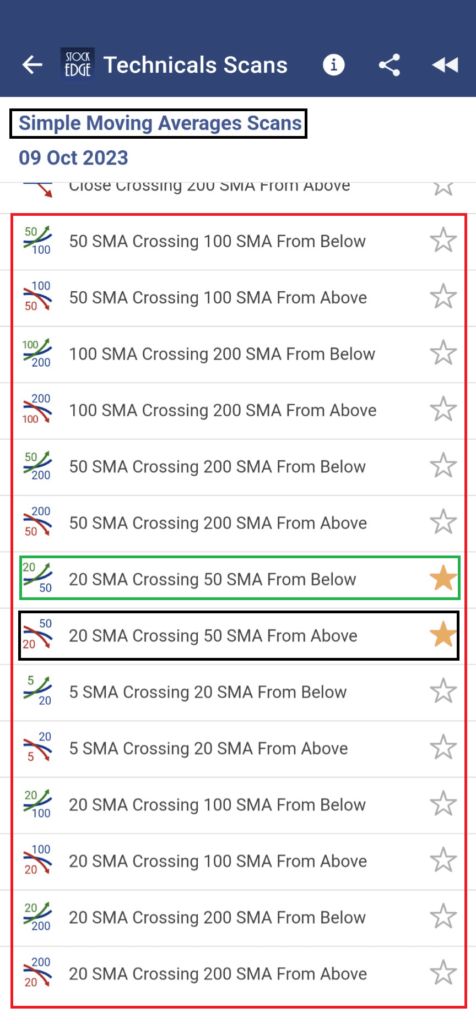
In the above image, you can see a combination of SMA crossovers. By clicking on each scan, it will show the list of stocks fulfilling the criteria. Also, you can mark your favorites by tapping on Star, as shown above.
To give you an example, we will discuss how you can create a bullish swing trade using a golden crossover (where 20 SMA crosses the 50 SMA from below)
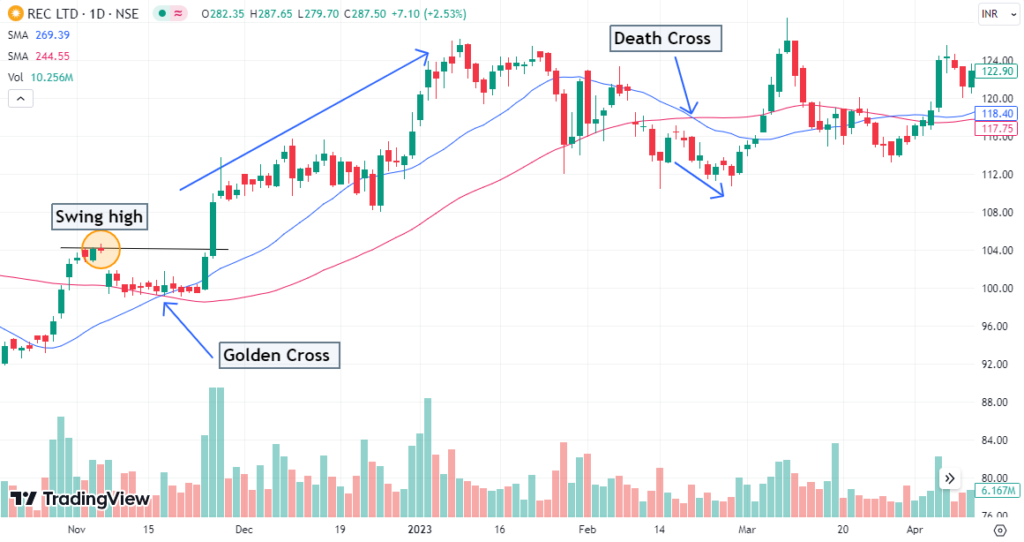
In the above chart of REC Ltd., you can see both the Golden Cross and the Death Cross. The blue line signifies 20 Day SMA (Shorter period SMA), and the red line signifies 50 Day SMA (longer period SMA).
When a Golden Cross occurs on the daily chart of REC Ltd., and the price gives a breakout above the previous swing high, then a sharp up move has taken place. On the other hand, you can also see a death cross on the price chart, after which the price did fall but not quite significantly. This indicates that SMA crossovers are not the ultimate swing trading strategy, but you should always look at other technical indicators as well before taking a trade.
The Third Strategy: MACD (Moving Average Convergence Divergence)
Moving Average Convergence Divergence (MACD) is the most widely accepted versatile technical indicator used to identify stocks for swing trading. It was developed by Gerald Appel in the late 1970s and is used to identify changes in the stock’s strength, direction, and momentum.
MACD consists of three main components:
- MACD Line (Fast Line): The MACD line is derived by computing the difference between the 12-period Exponential Moving Average (EMA) and the 26-period EMA. It represents the short-term momentum of a stock’s price.
- Signal Line (Slow Line): The signal line is a 9-period EMA of the MACD line. It acts as a smoothing or trigger line, providing trading signals.
- Histogram: The histogram is created by subtracting the signal line from the MACD line. It represents the difference between the MACD and the signal line and is used to identify the strength and direction of the trend. The MACD histogram visually illustrates the gap between the MACD and its 9-day EMA rather than depicting highs and lows. This histogram is positive when the MACD exceeds its nine-day EMA and negative when the MACD falls below it.
- Zero Line: The zero line on the histogram represents a point where momentum neither favors the bulls nor the bears; it indicates a neutral stance in the market.
How to Apply MACD in Trading?
For swing trading in stocks, MACD can be used for trend indemnification, and it can also generate buy-sell signals. Let’s find out how.
When the MACD line crosses above the signal line, it generates a bullish signal, indicating a potential uptrend. In contrast, when the MACD line crosses below the signal line, it generates a bearish signal, suggesting a potential downtrend.
Also, MACD going above or below the zero line indicates a bullish and a bearish signal for the stock.
Similar to SMA scans, you can also use the MACD Scans on StockEdge to identify stocks for swing trading based on MACD.

However, to increase the accuracy of trading signals, you must use MACD in conjunction with other technical indicators and analysis techniques, such as support and resistance levels, trendlines, and volume analysis.
Let’s now take a practical example of how MACD is used for swing trading in stocks. The strategy here is to identify a positive MACD crossover for a bullish trade and a negative MACD crossover for a bearish trade. As we have discussed earlier, a bullish signal is generated when the MACD line crosses over the signal line, while a bearish signal occurs when it crosses under the signal line. But when this crossover occurs above the zero line (when the histogram is positive, meaning MACD exceeds its nine-day EMA), it generates a much stronger buy signal compared to just the MACD line that crosses above the signal line.
The same goes for sell signals; when the crossover occurs below the zero line where the MACD line crosses below the signal line, it turns out to be a much stronger sell signal.
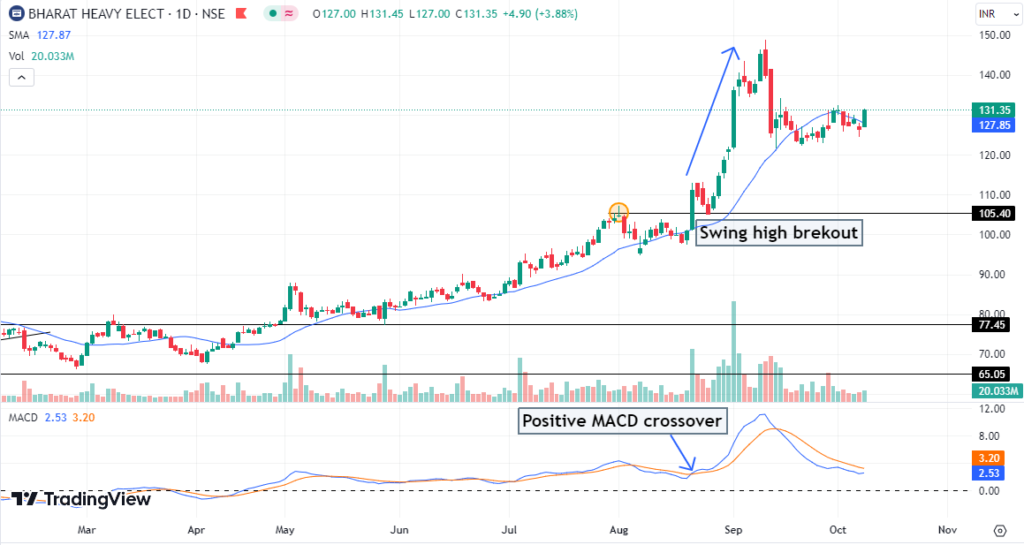
In the above example of BHEL Ltd.’s daily price chart, you can see when a positive MACD crossover occurs along with a price breakout above the previous swing high with relatively higher volume, and the price was trading above its short-term simple moving average of 20 days. The stock price jumped sharply, almost 30% in just two weeks.
This shows swing trading can be highly profitable with a defined strategy. These three are some of the best strategies for swing trading, which are easy and simple to implement for a beginner in the stock market. But, you must be careful about the market volatility, which may affect profitability on your swing trades.
However if you wish to do day trading you can read this blog: How to identify stocks for Intraday Trading?
How to Manage Volatility in Swing Trading?
Managing volatility in swing trading is crucial because price swings can impact your trades and risk exposure. Here’s a simple guide on how to manage volatility in swing trading:
- Adjust Position Size: In volatile markets, consider reducing your position size. Smaller positions mean lower risk if the market moves against you.
- Use Stop-Loss Orders: Set stop-loss orders to limit potential losses. Place them at levels that align with your risk tolerance.
- Risk-Reward Ratio: Maintain a favorable risk-reward ratio. Ensure potential profits justify the risk taken in each trade. Generally, a 1:2 risk-reward ratio is favorable for short-swing trades.
- Avoid trading in Earnings Announcements: Be cautious around earnings reports, as they can cause extreme price swings. Consider exiting positions before earnings if uncertain.
- Use Trailing Stops: Utilizing trailing stop orders as the stock price moves in your favor allows you to secure profits while simultaneously mitigating risk.
Remember that volatility can present opportunities as well as risks. With proper risk management and a well-defined trading plan, you can navigate volatile markets effectively in swing trading.
Although swing trading is a popular way to trade the stock market, there are other different types of trading, like intraday trading or positional trading, which are equally good and rewarding as well. So, why start with swing trading if you are especially a novice trader in the stock market?
Why Choose Swing Trading Over Other Trading Methods?
Swing trading can be a favorable choice for novice traders due to its lower time commitment, reduced stress, and accessibility. It allows beginners to learn at a comfortable pace, manage risk effectively, and fit trading into their daily routine. While no trading method is without risk, swing trading offers a balanced approach for those starting in stock trading.
So, if you are a beginner in stock trading, what are the steps you should follow for swing trading? Let’s find out!
What are the Key Steps to Start Swing Trading?
Here are the key steps to start your journey of swing trading as a novice trader.
Step 1: First and foremost, educate yourself about the basics of trading, technical analysis, and market dynamics. Read books on the stock market, and others learn from the market gurus about trading. Do proper research and analyze stocks before taking trades.
Step 2: Decide on the amount of capital you’re comfortable allocating to swing trading. Only use those funds that you can afford to lose.
Step 3: Create a comprehensive trading plan that outlines your goals and risk tolerance level. You must have entry and exit criteria before entering a swing trade.
Step 4: Choose your trading tools wisely. Although these tools can be expensive for any beginner, having effective trading tools enhances your knowledge and experience about the stock market. Try StockEdge!
Step 5: Try using demo accounts where you can practice swing trading without using real money. It’s a safe way to improve your strategies and get better at trading.
Remember that swing trading, like any form of trading, carries risks. It’s essential to approach it with caution and discipline and never trade with funds you cannot afford to lose. First, learn and then earn!
But are you considering swing trading as a full-time job? Wait before taking such steps! There are multiple factors to consider before making a wise decision.
Should You Consider Swing Trading as a Full-Time Job?
Yes or No! The answer is not that simple. It depends on multiple factors, including your financial situation, risk tolerance, experience, and personal preferences. Before considering, you must understand the Pros and Cons of being a full-time swing trader.
Pros and Cons of Being a Full-Time Swing Trader
Advantages of Full-Time Swing Trading:
- Flexibility: Swing trading offers flexibility in terms of time commitment. As a full-time trader, you have control over your schedule and can trade when it suits you.
- Potential Income: Successful swing traders can generate a consistent income. If you have a solid trading strategy and effective risk management, it can be a viable source of income.
- Independence: Full-time swing traders work independently, making their own decisions and not relying on a traditional job.
Considerations and Challenges:
- Financial Stability: It’s crucial to have sufficient capital to support your trading and cover living expenses during periods of losses or drawdowns. Trading full-time with limited capital can be risky.
- Experience: Novice traders may face a steep learning curve and are more susceptible to making costly mistakes. Consider starting part-time while gaining experience.
- Emotional Stress: Full-time trading can be emotionally taxing, especially during market downturns or when trades go against you. Emotional discipline is essential.
- Market Risk: The financial markets can be unpredictable, and there are no guarantees of profits. Always be prepared for both winning and losing streaks.
Still, if you are on the journey to become a full-time swing trader. Here are some tips for Considering Full-Time Swing Trading:
- Start Part-Time: If you’re new to trading, begin part-time to gain experience and assess your aptitude for it.
- Build a Financial Cushion: Ensure you have savings or another source of income to cover living expenses and trading capital during lean times.
- Continuous Learning: Invest in ongoing education and stay updated on market trends and trading strategies.
- Risk Management: Emphasize strict risk management to protect your capital and reduce the emotional toll of losses.
- Seek Professional Advice: Consult with financial advisors or experienced traders to get a realistic understanding of what full-time trading entails. You can join the StockEdge Club. It is a premium stock market community with experienced market professionals who are present to guide you through the ups and downs of the stock market.
The Bottom Line
In conclusion, full-time swing trading is a viable option for some, but it’s not without challenges and risks. Careful consideration of your financial situation, experience, and risk tolerance is essential before making the leap into full-time trading. Many traders choose to combine trading with other sources of income for added financial stability and risk mitigation.
Frequently Asked Questions (FAQs)
1. What is swing trading and how is it different from other trading strategies?
Swing trading aims to capture short to medium-term stock price movements, differing from day trading (intraday) and long-term investing (holding for years)
2. Is Swing Trading Suitable for Beginners?
Yes, swing trading can be suitable for beginners with proper education and risk management.
3. What are some key indicators to look for when identifying potential swing trades?
Some commonly used key indicators to look for when identifying potential swing trades include moving averages, support and resistance levels along with chart patterns such as triangles and channels.
4. What are some common mistakes beginners make when swing trading?
Some common mistakes beginners make in swing trading include overtrading, not having a clear trading plan, and letting emotions drive their decisions.
5. Why is swing trading better than intraday?
Swing trading is often considered better than intraday trading for some traders because it offers more flexibility and less time commitment while still capturing meaningful price moves.


